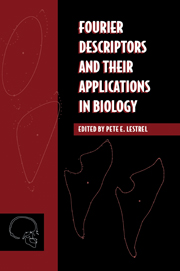Book contents
- Frontmatter
- Contents
- List of contributors
- Preface
- Acknowledgments
- Part one Theoretical considerations
- 1 Introduction
- 2 Introduction and overview of Fourier descriptors
- 3 Growth and form revisited
- 4 Methodological issues in the description of forms
- 5 Phase angles, harmonic distance, and the analysis of form
- Part two Applications of Fourier descriptors
- Appendix
- Glossary
- Index
4 - Methodological issues in the description of forms
Published online by Cambridge University Press: 14 September 2009
- Frontmatter
- Contents
- List of contributors
- Preface
- Acknowledgments
- Part one Theoretical considerations
- 1 Introduction
- 2 Introduction and overview of Fourier descriptors
- 3 Growth and form revisited
- 4 Methodological issues in the description of forms
- 5 Phase angles, harmonic distance, and the analysis of form
- Part two Applications of Fourier descriptors
- Appendix
- Glossary
- Index
Summary
Introduction
There are many situations in which biologists wish to compare morphology. These include studies of normal and pathological variation, growth, and evolution. Each presents its own morphometric challenges. In the study of the shapes of populations of cells, for example, there may be a lack of unequivocally definable equivalent landmarks on which to base comparative measurements. In this case the investigator seeks morphometric methods that show little dependence on landmark identification. In contrast, studies of variation in skull shape might be based on landmarks that are equivalent between individuals in an evolutionary, developmental, or functional sense. Thus, comparative data may be based upon the relative locations of these landmarks rather than upon the shape or curvature of the outline itself.
In undertaking a morphometric study, one chooses, then, between methods that describe forms in terms of landmarks or interlandmark distances, and those that describe form with little or no reference to landmarks. There are, however, a large number of other issues involved; these are, to a degree, dependent on the problem at hand and the particular questions being addressed. For instance, in choosing landmarks, questions may arise concerning homology, the sampling of form, and the types of measurements to be taken.
- Type
- Chapter
- Information
- Fourier Descriptors and their Applications in Biology , pp. 74 - 105Publisher: Cambridge University PressPrint publication year: 1997
- 19
- Cited by



